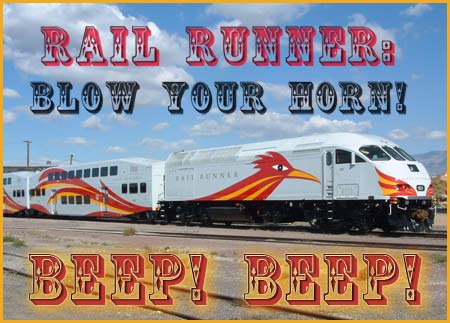
I inadvertently became the object of media attention when I boarded the New Mexico Rail Runner Express Train at 5:10 a.m. on Fri., July 14, 2006. The reason I was courted by the press was because I had brought my 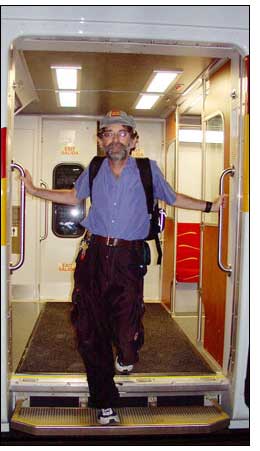 bike on the train.
bike on the train.
There were about 50 people who rode on this, the Rail Runner’s maiden run, and I was the only person with a bike. Consequently the media, who practically outnumbered passengers, flocked to me.
I guess the reporters were scraping the bottom of the bucket. They had photographed the train with its beautiful roadrunner motif, they had interviewed many passengers and they had rattled off impressive statistics, but the sight of my bike really got them going. Before I knew it cameramen and newspeople surrounded me as if I were a celebrity.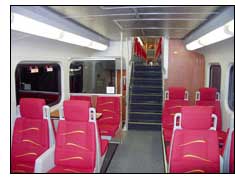
I was later seen on TV and my picture appeared on page two of the Albuquerque Journal along with a few words that were faithfully transcribed by Lloyd Jojola,
"This train is the best thing that has happened to New Mexico in 30 years because this train serves all New Mexicans, not just a few of them," I told the roving journalist who described me as in his article as a 49-year-old editorial technician who “grounded himself a decade ago and now only takes Amtrak to travel the country.”
As I read my words in the next day’s paper I was amazed that I was so coherent. I had spent 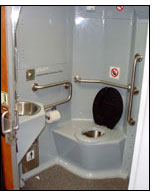 the previous night dancing and drinking at the AMEREM banquet at the Convention Center with some of the world’s most renowned scientists and I was a bit hung over.
the previous night dancing and drinking at the AMEREM banquet at the Convention Center with some of the world’s most renowned scientists and I was a bit hung over.
But even though I wasn’t my usual self I knew that I had to be on the maiden voyage of the Rail Runner. As a dyed in the wool “railfan” I understood that this was an historic occasion and I wanted to be a part of it.
The Rail Runner is a commuter railroad that caters to those who travel from outlying communites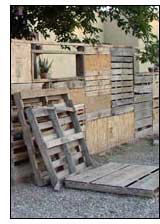 to work in the city. As such, there are only three trains that run in the morning and three runs in the evening, with one run at noon for good measure.
to work in the city. As such, there are only three trains that run in the morning and three runs in the evening, with one run at noon for good measure.
The trains travel at about 65 mph and, for the most part, ride on class four welded rails, which make for a reasonably comfortable ride. By that evening over 4,000 people had ridden on the train.
The Rail Runner will be allowing riders to travel for free during its first three months of operation. The cars are clean and spacious and there is even a nice bathroom on board. Each car can carry about 150 passengers and the locomotives will soon be running on biodiesel, one of the first such conversions in the country. Each car seems to have two distinct levels as well as a third, transitional level. The seats are not adjustable, but they are sturdy, attractively upholstered in cloth and will probably hold up for a long time.
free during its first three months of operation. The cars are clean and spacious and there is even a nice bathroom on board. Each car can carry about 150 passengers and the locomotives will soon be running on biodiesel, one of the first such conversions in the country. Each car seems to have two distinct levels as well as a third, transitional level. The seats are not adjustable, but they are sturdy, attractively upholstered in cloth and will probably hold up for a long time.
The train makes only two stops after leaving downtown, but that is soon to change. Stations are being built as far south as Belen and, in a few years, will go all the way to Santa Fe. The train was funded by Governor 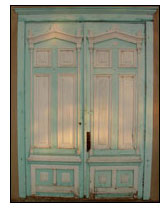 Richardson’s Investment Partnership and was the only non-asphalt project within its program. New Mexico got a bargain when they built this heavy-duty transportation system.
Richardson’s Investment Partnership and was the only non-asphalt project within its program. New Mexico got a bargain when they built this heavy-duty transportation system.
When I arrived in Bernalillo I rode by bicycle around town and, although just about everything was closed, I enjoyed looking at the many murals and old buildings that line the main street. I saw a door to a Catholic church that was very pretty and the wall of an old adobe brick house. I admired the fence of a house that was entirely built out of wood pallets. The pallets were hung straight, plumb and true and although the material was somewhat unorthodox, I couldn’t help but marvel at the quality of its construction.
Having toured a little bit of Bernallillo, I headed back to the railroad station, goaded by the sound of the train’s distant horn blowing in the distance.
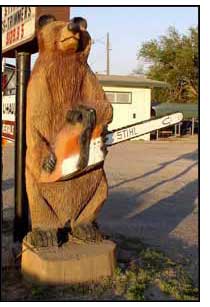 It seems that many residents who live along the Rail Runner’s route are irritated by the sound of the Rail Runner’s train whistle. Meetings are being called, letters to the editor are being written and people are in an uproar.
It seems that many residents who live along the Rail Runner’s route are irritated by the sound of the Rail Runner’s train whistle. Meetings are being called, letters to the editor are being written and people are in an uproar.
The solution to this particular noise problem is known in railroad circles as a “static crossing horns” and Ames, Iowa has one at every crossing in town. Instead of the engineer blowing his horn in all directions, a static horn is situated at every crossing and begins to blow when a train approaches. The static horn is aimed down the street so that it can get the attention of drivers and create minimal distraction to homes and businesses. The train engineer always has the option of blowing his whistle when life or property is in danger.
I eventually rode my bike to the station and enjoyed the 25-minute, 18-mile ride home. This time I was not the only bicyclist on board. As a matter of fact I had a hard time finding a place to put my bicycle among all the new riders who had seen me board the train on the morning news.
Thank you for visiting Chucksville.
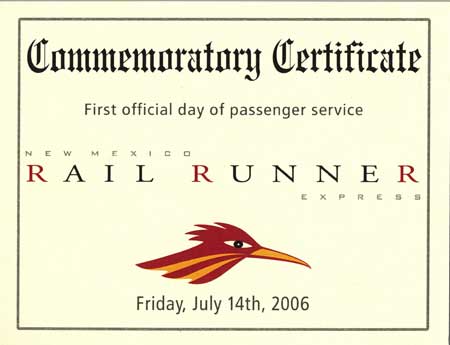

|
|


